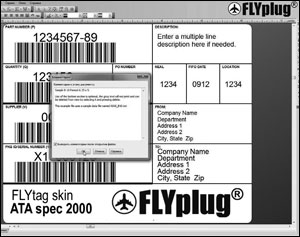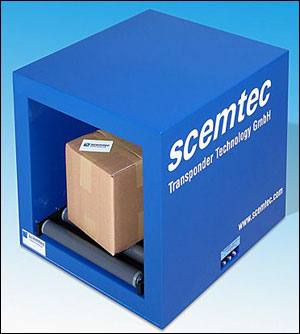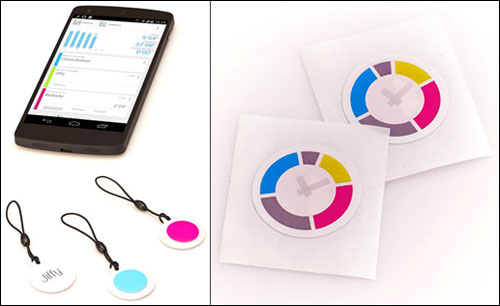The following are news announcements made during the past week by the following organizations:
MAINtag, Zebra Technologies;
Avery Dennison, Round Rock Research;
Scemtec, Smartrac;
Qualcomm;
Nordic Usability; and
IXYS.
MAINtag, Zebra Launch FLYplug RFID Printing Solution for Aircraft Parts
MAINtag has partnered with Zebra Technologies to launch FLYplug, an integrated RFID printing-encoding solution based on the ATA specifications known as Spec 2000. The RFID printing solution includes software (which can be used either standalone or networked), Zebra’s RFID printers (the RZ400, RZ600 and R110Xi4 series, as well as the new ZT410R and ZT430R lines) and MAINtag’s on-metal ruggedized FLYchip-embedded RFID tags. The FLYchip, unveiled about a year ago (see RFID News Roundup: MAINtag Introduces New RFID-enabled, ATA Spec 2000-compliant FLYchip), conforms to Spec 2000 and is embedded in the FLYtag range of RFID tags. The ultrahigh-frequency (UHF) RFID chip is compliant with the EPC Gen 2 and ISO 18000-6C standards (meeting requirements in the most recent EPC TDS 1.6 standard). In February 2014, MAINtag unveiled the FLYchip64 (see RFID News Roundup: MAINtag Launches FLYchip64 High-Memory Chip for Aerospace). FLYplug is certified by Oracle and SAP for integration with those systems; features intuitive wizards to allow the easy design of custom forms with data entry and/or Web-based templates; and can access most databases (ODBC, OLE DB and non-Windows, such as AS/400, SAP, LINUX and Oracle), spreadsheets or texts. In addition, the solution can send out automatic e-mail alerts warning of errors or problems, and includes .NET software development kits (SDKs) so customers need not write custom integrations from scratch (for example, a sample Web application, ASP.NET, can be used to enable Web browser printing).
Avery Dennison Simplifies Round Rock Licensing Requirements for Retailers
Avery Dennison Retail Branding and Information Solutions (RBIS), a provider of RFID-based inventory-management solutions for apparel, has announced s revision to the licensing agreement it has with Round Rock Research LLC regarding RFID tags, labels, and readers. Avery Dennison had signed the agreement in November 2013 (see Avery Dennison, Alien Technology and Invengo Sign Licensing Deals With Round Rock) to settle a dispute with the patent-licensing firm. The agreement allowed Avery Dennison (and other companies) to continue selling products while paying undisclosed licensing fees to Round Rock, a patent-assertion entity that holds 10 patents related to RFID technology. The original licensing agreements had included auditing processes that retailers had to follow, but the agreement now encompasses a simplified audit process that should make it easier for retailers and other end users to meet Round Rock’s audit and certification requirements. By removing what could have been seen as a barrier to implementing RFID technology and simplifying the auditing process, Avery Dennison believes the new arrangement will accelerate RFID adoption and that U.S.-based apparel retailers and manufactures that use Avery Dennison RFID inlays will expend less time and energy implementing RFID, as well as reduce risks. In a prepared statement, Jim Burris, Round Rock Research’s VP of licensing, said, “We have reviewed Avery Dennison’s ability to track RFID tags and labels and consider the end to end visibility provided through their service bureaus and other customer based solutions sufficient to allow end users to meet audit and certification requirements necessary under Round Rock’s licensing program to confirm that RFID tags are licensed.”
Scemtec, Smartrac Partner on RFID Document-Tracking System
Scemtec Transponder Technology and Smartrac have announced that they have jointly developed RFID components designed for automatic document management, control of document stock and comprehensive document tracking. The combined solution includes scemtec’s RFID readers and Smartrac’s RFID transponders. Scemtec provides RFID read-write equipment and antennas for document identification, such as inventory management or the archiving of documents, and its solutions are used to capture all media data and prevent document theft, swapping or any other kind of mishandling. A scemtec system typically consists of the company’s high-frequency (HF) Long-Range Reader (SIL-2125) or HF Midrange Reader (SIR-2720)—both of which support the EPC Class 1 HF and ISO 18000-3 Mode 3 standards—and scemtec’s HF 3D antenna system (SAT-Tunnel-13MHz). According to the two companies, these components have the ability to detect labels independent of their orientation inside the tunnel. Smartrac’s new Block RFID transponder is based on the EPC Class 1 HF and ISO 18000-3 Mode 3 standards, and is designed for use with document stacks. The Block inlay utilizes NXP Semiconductors‘ ICode ILT-M RFID chip with a 96-bit tag identifier (TID), 240 bits of Electronic Product Code (EPC) memory and 512 bits of user memory for document identification when close stacking occurs, the two companies report. With their technologies combined, the firms note, scemtec’s RFID hardware is capable of reading more than 500 Smartrac Block tags simultaneously.
Qualcomm’s Gimbal Beacon Featured at Tribeca Film Festival
Qualcomm has announced that its Gimbal Proximity Beacons—battery-powered tags that transmit a unique ID number via the Bluetooth Low Energy (BLE) protocol—are being used in conjunction with the Tribeca Film Festival‘s official 2014 festival application. The Tribeca Film Festival—Official Mobile Event Guide app was developed for Apple iPhone devices by Eventbase. The Gimbal context-aware and proximity platform, according to Qualcomm, is being used to provide ticket offers, festival promotions, movie trailers and surveys that allow visitors to share their festival experience. The app, which is now available at the iTunes App Store, also lets fans vote on films debuting this year. Gimbal Proximity Beacons are designed to be highly accurate (within a few feet), Qualcomm reports, so that micro-location information can be delivered (assuming a user has opted in to receive push notifications). The beacons are at numerous locations around the festival, which is being held in Lower Manhattan on Apr. 16-27, 2014. Additional beacons are located on outdoor properties owned by Titan, an outdoor advertising firm. Last month, Qualcomm announced that it had been chosen by Major League Baseball Advanced Media (MLBAM), the Internet and interactive branch of Major League Baseball, to supply Bluetooth Beacons to 20 ballparks for opening day of the 2014 MLB season (see RFID News Roundup: Qualcomm Provides Bluetooth Beacons for Major League Baseball’s ‘At The Ballpark’ App).
Nordic Usability Launches NFC RFID JiffyTags Designed for Time-Tracking
Nordic Usability has announced that its Android App Jiffy now works with Near Field Communication (NFC) RFID-enabled JiffyTags. Operating much like a stopwatch, Jiffy is a time-tracking application designed for tracking and accurately reporting work or project time, Nordic Usability explains. The app is available from the Google Play app store. By affixing JiffyTags to various objects contextually relevant to a project—for example, notebooks, folders, or keys—users can activate the Jiffy app by tapping their NFC-enabled smartphones to tagged objects and tracking time in the project linked to each particular tag. JiffyTags can also be shared among colleagues, making them suitable for mounting outside meeting rooms, or at an office entrance. The Jiffy key fobs and stickers are made with NXP Semiconductors‘ NTAG203 RFID chip, Nordic Usability reports, and are designed to work with as many phones as possible, by using the widely accepted standard NTAG203. “We have identified that the most difficult thing about time tracking is that it is so easy to forget,” said Lorica Claesson, Nordic Usability’s user experience designer and founder, in a prepared statement. “JiffyTags help our users remember by working both as a visual queue, as well as a trigger to start tracking your project.” Unlike with most NFC tags, the company explains, JiffyTags are already prepared and will be recognized by the Jiffy app. When first held to the back of a phone, Jiffy asks which project it should be linked to, and the association is made within the app, the company says. Within the app, projects can be distinguished by different colors, which are represented on the JiffyTags to enable visual identification as well. Available now, the key fobs come with elastic bands and changeable color labels, and the stickers have the Jiffy symbol printed on top. The JiffyTags are sold online on Jiffy website, at a cost of €10 ($13.83) for three key fobs or five stickers.
IXYS Intros 134.2 kHz Passive RFID ICs With Built-in Temperature Sensors
IXYS Corp., a semiconductor company, has announced an integrated circuit (IC) family designed for the production of low-frequency (LF) RFID tags that perform in harsh and challenging environments and are designed for agricultural and medical applications. The products all work in the 134.2 kHz range, and will comply with the ISO 11784 and 11785 specifications. Products include the NCD1015, an integrated RFID tag for harsh environments that contains four memory blocks of 33 bits each, suitable for electronic animal identification; the NCD 1025, an RFID IC with 8 memory blocks of 33 bits each and an integrated on-silicon temperature sensor, negating the need for external components to sense and report temperatures; and the NCD1100, which is optimized for tags on metal with a dedicated antenna and synchronous collision-avoidance logic. The ICs were developed by INCIDE, a business that IXYS recently acquired and renamed IXYS San Sebastian (ISS). “Adding RFID ICs and RFID tags to our application specific IC products will enable IXYS to provide essential location and tracking capabilities within customers’ products in the medical, industrial, transportation, telecommunication, security and agricultural industries,” said IXYS’s CEO, Nathan Zommer, in a prepared statement. “We believe our customers will gain a competitive advantage, utilizing our unique low power RFID products that wirelessly transfer information and measurements, even in harsh conditions. The combination of RFID ICs and our extensive line of MCUs enables the production of smart digital RFID tags for our target markets.” The new products will be sold through IXYS’ IC sales channels, the company reports.




